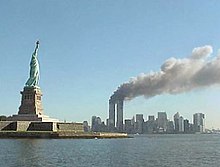Renegade (aviation)

The English-language term Renegade ( English for renegade , defector ) describes in a criminalistic context a flying airliner that is suspected of being used by air pirates as a weapon for a terrorist attack against ground targets .
Renegade cases are special forms of aircraft hijacking with an extremely high level of criminal energy. Terrorists particularly use the kinetic energy of the aircraft and the flammability of the kerosene in order to achieve the greatest possible effect on the object and a high number of victims among passengers , flight personnel and the attacked persons on the ground.
The official definition in Germany is as follows:
"Situation in which there is a presumption, suspicion or certainty that an aircraft is to be used as a weapon for terrorist or other motives."
Such locations are characterized by the fact that the life and physical integrity of numerous people can be significantly impaired or damaged.
The term has established itself internationally since 2002 as a result of the terrorist attacks on September 11, 2001 in the USA . Previously, Renegade was used in English to denote aircraft hijacking.
Defense against renegades in Germany
The defense and possible shooting down of a Renegade is solely the national responsibility. For example, NATO is not authorized to make decisions about the use of weapons against Renegades.
In Germany, the National Situation and Command Center for Airspace Security was set up in the municipality of Uedem in North Rhine-Westphalia in October 2003 in order to protect German airspace from such threats .
In the event of a renegade, the command center has two alarm groups stationed in Neuburg an der Donau in Bavaria and in Wittmund in East Frisia , consisting of Eurofighter aircraft, which are constantly kept ready for take-off and can be in the air within 15 minutes.
The aim of the fighter aircraft is to first visually identify the suspicious airliner in their function as an interceptor and, if possible, to establish radio contact with the hijackers. If they do not react or ignore the request to land, the combat aircraft will attempt to push the aircraft away by means of appropriate maneuvers and force it to land. The last warning consists of the use of the on- board cannon in the form of a fired sheaf ( warning shot ). The fighter is positioned to the left and slightly above the cockpit next to the civil aircraft so that the use of weapons can be seen and heard. The last resort against a Renegade aircraft, the shooting down of the commercial aircraft, is currently not covered by law in Germany.
The Section 14 para. 3 of the Aviation Security Act , which the Minister of Defense would have the right under Article 35 of the Basic Law to allow shoot-aircraft Renegade, was by a decision of the Federal Constitutional Court in early 2006 as unconstitutional considered. For the criminal liability of shooting down a Renegade aircraft, see supra-legal emergency .
Defense against renegades in Switzerland and Liechtenstein
The Swiss Air Force is responsible for the security of the Swiss and Liechtenstein airspace. The airspace is controlled 24 hours a day all year round with the FLORAKO airspace monitoring system. The Swiss Air Force currently has two armed F / A-18s on QRA 15 all year round from 6:00 a.m. to 10:00 p.m. From the end of 2020, this will be permanently expanded to an uninterrupted 24-hour standby. If it becomes apparent that a suspected renegade represents a hazard, a shooting down is possible with the definition of an emergency or self-defense. The kill order is communicated directly by the Minister of Defense or the Commander of the Air Force via the CAD (Chief Air Defense), whereby the fighter jet pilot has the final decision on the use of weapons, as he can be the first to assess an escalation or de-escalation. After being called on the international emergency frequency and the ICAO standard communication maneuver, the Swiss Air Force uses the firing of clearly visible flares (magnesium flares ) as a final warning of the possible use of weapons (as a “ shot in front of the bow ”, so to speak ). On the basis of international treaties, the Swiss Air Force is entitled to use armed fighter planes to penetrate the national airspace of neighboring countries in a renegade case. However, the use of weapons outside of Swiss airspace is not permitted.
See also
Web links
Individual evidence
- ↑ Information on the hearing on November 9, 2005 regarding the Aviation Security Act; Press release No. 101/2005. Federal Constitutional Court , October 17, 2005, archived from the original on December 25, 2015 ; accessed on November 2, 2018 : "Renegade aircraft (...) are civil aircraft that are used for terrorist or other motivated purposes as a weapon for a targeted crash."
- ↑ BVerfGE 115, 118